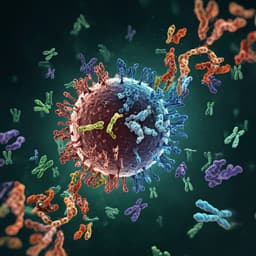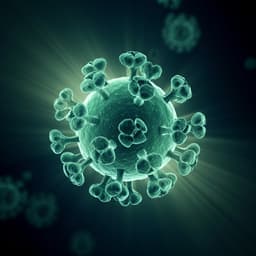
Medicine and Health
Understanding the effectiveness of government interventions against the resurgence of COVID-19 in Europe
M. Sharma, S. Mindermann, et al.
European governments utilized non-pharmaceutical interventions during the second COVID-19 wave. This research evaluates the effectiveness of 17 NPIs, revealing that while measures like business closures and gathering bans aided in reducing transmission, their impact was not as strong as in the first wave. Conducted by a diverse group of authors from various prestigious institutions, the findings offer valuable insights into public health strategies.
~3 min • Beginner • English
Introduction
The study addresses how effective specific non-pharmaceutical interventions were during Europe’s second COVID-19 wave (approximately August 2020–January 2021), given that first-wave estimates likely overstate current effects due to widespread adoption of organisational safety measures and individual protective behaviours. Governments implemented more granular NPIs in later waves (e.g., sector-specific business closures, small gathering limits, curfews), requiring updated, subnationally resolved estimates. The research aims to quantify the effects of 17 NPIs on transmission, measured as percentage reductions in the instantaneous reproduction number Rt, and to assess whether second-wave estimates better inform ongoing policy and predict subsequent waves compared with first-wave estimates.
Literature Review
Prior first-wave analyses linked NPI timing to epidemic trajectories across countries and found substantial effects for broad measures like school closures, business closures, and large gathering bans. However, first-wave estimates reflected pre-pandemic baselines without safety measures and different adherence patterns, and NPIs were often implemented nearly simultaneously, complicating identification of individual effects. Subsequent waves featured more granular policies (e.g., targeted sector closures, stricter small gathering limits, curfews) and sustained behavioural changes, motivating updated estimates. The paper situates itself against extensive first-wave literature (e.g., Nature, Science, Lancet Infectious Diseases studies) and tiered restriction analyses in England and Italy, highlighting the need for subnational data and models that accommodate unobserved changes in transmission.
Methodology
Data: The authors assembled a custom, manually validated dataset of NPI implementations at subnational level across 114 regions in 7 European countries (Austria, Czech Republic, England, Germany, Italy, Netherlands, Switzerland) covering 1 Aug 2020–9 Jan 2021. Over 5,500 NPI entries were collected with dates, quotes, and sources (government/legal/media). Regions were selected to align with administrative units where NPIs were uniform; some countries contributed all regions, others a stratified random sample (by first-wave deaths). Regions with fewer than 2,000 reported cases during the period were excluded. Data underwent semi-independent double entry, cross-country harmonisation of definitions, external validation, and automated plausibility checks. To avoid bias from VOC B.1.1.7, observations after it exceeded 10% prevalence were truncated in affected English regions.
NPIs: Seventeen NPIs were defined with second-wave granularity, including closures (night clubs; gastronomy; retail and close-contact services; leisure and entertainment venues; educational institutions—primary, secondary, universities), gathering restrictions (public gatherings and private household mixing with thresholds: ≤30, ≤10, 2 people, or banned), stricter mask-wearing policies (most or all shared/public spaces), and nighttime curfews. Educational closures accounted for term and holiday periods; university “closure” required students to have left university towns.
Model: A semi-mechanistic hierarchical Bayesian transmission model links NPI activation to changes in the instantaneous reproduction number Rt. Rt for location l on day t depends on: (a) an initial reproduction number R0 (prior: truncated Normal mean 1.35, sd 0.3); (b) multiplicative effects of active NPIs parameterised by shared effect parameters βi (Asymmetric Laplace prior centred at 0 with shrinkage favouring small positive effects); and (c) a location-specific latent weekly random walk zt (σz ~ Half Normal(0.15)) capturing unobserved, lasting changes in transmission (e.g., unrecorded NPIs, adherence shifts). Rt evolves multiplicatively with exp(εt) from the random walk, enabling flexibility beyond recorded policies.
Infection process: New infections follow a discrete-time renewal equation using a discretised generation interval (Gamma mean 4.83 days, sd 1.73). To handle low-incidence stochasticity, additive Gaussian noise with softplus rectification is added to the expected infections. Initial unobserved infections are seeded for the first week from a Lognormal prior.
Observation models: Expected reported cases and deaths are computed by convolving infections with delay distributions from infection to case confirmation and infection to death, respectively. Delays are built from second-wave data: incubation period (Gamma mean 5.53, sd 4.73) plus onset-to-confirmation (Gamma mean 5.28, sd 3.75) and onset-to-reported death (Gamma mean 18.61, sd 13.62) derived from linelists (Austria, Germany, UK). Observed cases and deaths follow negative binomial likelihoods with country-specific dispersion (Half Normal(5)). The model is scale-invariant to time-invariant IFR/IAR; IFRl has a Uniform[1e-3,1] prior (effectively a case-fatality rate due to IAR set to 1). Sensitivity analyses also used time-varying IFR/IAR estimates for England.
Inference: Implemented in NumPyro with NUTS (4 chains, 250 warmup, 1250 samples per chain; 5000 posterior draws), with convergence diagnostics. Robustness was assessed via 17 sensitivity analyses (86 conditions) varying priors, delay distributions, model structure, data subsets, and potential unobserved confounders, plus additional validation (posterior predictive checks, simulations, multivariate sensitivity, and a single-model meta-analysis across regions).
Prediction generalisation: Using national NPI data for 6 countries (Jan–May 2021), observed changes in Rt upon implementing/lifting NPIs during the third wave were compared against predictions based on first- versus second-wave estimates.
Key Findings
- Overall effect sizes were smaller in Europe’s second wave than in the first. Across all NPIs studied, Rt was reduced by 66% (95% CI: 61–69%) versus median 77–82% in the first wave. Considering the most stringent set actually implemented in each region, the reduction averaged 56% (95% CI: 40–64%) versus 76–82% in the first wave. Average Rt dropped from a maximum 1.7 (95% CI: 1.4–2.4) to a minimum 0.7 (95% CI: 0.5–0.8), compared with 3.3–3.8 to 0.7–0.8 in the first wave.
- Business closures were particularly effective (combined reduction 35%, 95% CI: 29–41%). Specific sectors: gastronomy closures 12% (95% CI: 8–17%); night clubs 12% (95% CI: 8–17%); retail and close-contact services combined 12% (95% CI: 7–18%); leisure and entertainment venues 3% (95% CI: 1–10%).
- Gathering restrictions: banning all gatherings (public and private) reduced Rt by 26% (95% CI: 18–32%). Stricter thresholds (e.g., 2-person limits) were substantially more effective than lenient limits; limits of ≥10 persons had small effects in the second wave, contrasting with first-wave findings.
- Private household mixing restrictions contributed meaningfully only at very strict thresholds (2 people allowed) or bans; public gathering restrictions also reduced transmission, but total impact of banning all private mixing exceeded that of banning public gatherings.
- Educational institution closures had a small effect in the second wave: 7% (95% CI: 4–10%), in stark contrast to large first-wave effects, likely reflecting safety measures and behavioural changes in schools and universities.
- Stricter mask-wearing policies (mandating masks in most or all shared/public spaces) reduced Rt by 12% (95% CI: 7–17%).
- Nighttime curfews reduced Rt by 13% (95% CI: 6–20%), with effectiveness potentially context-dependent (e.g., less added benefit when all gatherings are already banned).
- A “lockdown” defined as a ban on all gatherings plus closure of all nonessential businesses reduced Rt by 52% (95% CI: 47–56%).
- Generalisation: First-wave estimates overpredicted third-wave Rt changes by an average of 18 percentage points, whereas second-wave estimates overpredicted by only 2 percentage points, indicating better predictive validity for later waves under similar safety behaviours.
- Sensitivity/robustness: Across 86 experimental conditions, relative rankings of NPIs were broadly stable; while medians shifted with assumptions, key qualitative conclusions held, suggesting robustness to plausible unobserved factors and modelling choices.
Discussion
The findings indicate that NPI effectiveness is context-dependent and diminished in the second wave relative to the first, likely due to widespread organisational safety measures (e.g., ventilation, distancing, testing) and individual protective behaviours that reduced baseline transmission in public and social settings. Consequently, the marginal benefits of closing institutions or broadly banning activities were smaller than early in the pandemic. This dynamic underscores that policy should consider counterfactual behaviour and safety protocols when assessing NPIs. The analysis disentangles more granular second-wave interventions thanks to subnational data and temporally staggered implementations, showing that targeted business closures and strict small gathering restrictions deliver substantial reductions in transmission, whereas lenient gathering limits and educational closures (with safety measures in place) yield smaller additional benefits. Mask mandates and curfews provide moderate additional reductions but may interact with other NPIs. Second-wave effect estimates better predicted third-wave changes, supporting their use for ongoing decision-making under similar behavioural and safety contexts. The work emphasises the need to update effectiveness estimates over time, particularly with emerging variants and vaccination altering transmission patterns and demographic risk, which may shift the relative benefits of specific NPIs (e.g., those targeting younger populations).
Conclusion
Using a large, validated subnational NPI dataset and a flexible hierarchical Bayesian transmission model, the study provides second-wave effectiveness estimates for 17 NPIs in Europe. It shows closures and bans continued to reduce SARS-CoV-2 transmission but less than in the first wave, with strong effects for targeted business closures and strict gathering limits, modest effects for stricter mask policies and curfews, and small additional effects from educational closures under robust safety measures. Second-wave estimates generalised better to third-wave outcomes, indicating their relevance for policy in ongoing pandemic conditions. The authors advocate incorporating evolving safety behaviours and organisational protocols into policymaking and modelling, and prioritising real-time estimation frameworks that track changing NPI effects. Future work should expand to more countries and contexts, quantify interactions among NPIs, integrate contemporaneous measures of adherence and safety protocols, and assess how variants and vaccination coverage modulate NPI effectiveness.
Limitations
The analysis is observational and subject to unobserved confounding; while a latent random walk and extensive sensitivity analyses mitigate this, the true strength of confounders (e.g., unrecorded NPIs, adherence changes) is unknown. Estimates assume NPI effects are shared across regions (with flexibility via the random walk), which may miss local heterogeneity. The study covers seven European countries and a specific time window (Aug 2020–Jan 2021), potentially limiting generalisability to other settings or periods with different behaviours, variants, or vaccination levels. Assumptions include time-invariant ascertainment and fatality scaling (with robustness checks), specified delay distributions, and model structure; results are sensitive within plausible bounds but high-level conclusions remain. Expressing effects as multiplicative percentage reductions assumes diminishing returns at low transmission and may not capture all interactions among NPIs. Curfew and mask effects may depend on concurrent NPIs, and disentangling closely timed policies for certain gathering categories remains challenging.
Related Publications
Explore these studies to deepen your understanding of the subject.







